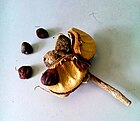Note: This is a project under development. The articles on this wiki are just being initiated and broadly incomplete. You can Help creating new pages.
Magnolia champaca - Champaka
Contents
- 1 Uses
- 2 Parts Used
- 3 Chemical Composition
- 4 Common names
- 5 Properties
- 6 Habit
- 7 Identification
- 8 List of Ayurvedic medicine in which the herb is used
- 9 Where to get the saplings
- 10 Mode of Propagation
- 11 How to plant/cultivate
- 12 Commonly seen growing in areas
- 13 Photo Gallery
- 14 References
- 15 External Links
Uses
Leprosy, Boils, Itching, Dyspepsia, Nausea, Fever, Puerperal mania, Delirium, Maniacal excitement, Renal diseases, Gonorrhoea, Inflammation.
Parts Used
Flowers, Fruits, Leaves, Roots, Bark.
Chemical Composition
It contains isoeugenol, benzoic acid, benzyl alcohol, benzaldehyde, cineol and p -cresol methyl ether.[1]
Common names
| Language | Common name |
|---|---|
| Kannada | Sampagebuvon, Sumpaghy |
| Hindi | |
| Malayalam | Bongas jampacca, Champakam |
| Tamil | Shampang, Shembugha |
| Telugu | Shampangi-puvon, Champakamu |
| Marathi | |
| Gujarathi | Champo, Pilo champo |
| Punjabi | |
| Kashmiri | |
| Sanskrit | |
| English |
Properties
Reference: Dravya - Substance, Rasa - Taste, Guna - Qualities, Veerya - Potency, Vipaka - Post-digesion effect, Karma - Pharmacological activity, Prabhava - Therepeutics.
Dravya
Rasa
Tikta (Bitter), Kashaya (Astringent), Katu
Guna
Laghu, Rooksha
Veerya
Sheeta
Vipaka
Katu
Karma
Kapha, Vata, Pitta
Prabhava
Habit
Identification
Leaf
| Kind | Shape | Feature |
|---|---|---|
| Simple | Spiral | Petiole 1-3 cm long, stout and planoconvex in cross section |
Flower
| Type | Size | Color and composition | Stamen | More information |
|---|---|---|---|---|
| Solitary | 2-4cm long | Yellow | Flowering are Axillary and Fragrant |
Fruit
| Type | Size | Mass | Appearance | Seeds | More information |
|---|---|---|---|---|---|
| Follicles | 2-3 cm long | Arranged as spike | 1 | Fruits are Dehiscing dorsally |
Other features
List of Ayurvedic medicine in which the herb is used
Where to get the saplings
Mode of Propagation
How to plant/cultivate
A plant of the wet tropics and subtropics, also able to be grown in the warm temperate zone. It is found growing at elevations from near sea level to 2,100 metres.[3]
Commonly seen growing in areas
Temperate area, Cultivated areas, Himalayas region.
Photo Gallery
References
External Links
- Pages that are stubs
- Ayurvedic Herbs known to be helpful to treat Leprosy
- Ayurvedic Herbs known to be helpful to treat Boils
- Ayurvedic Herbs known to be helpful to treat Itching
- Ayurvedic Herbs known to be helpful to treat Dyspepsia
- Ayurvedic Herbs known to be helpful to treat Nausea
- Ayurvedic Herbs known to be helpful to treat Fever
- Ayurvedic Herbs known to be helpful to treat Puerperal mania
- Ayurvedic Herbs known to be helpful to treat Delirium
- Ayurvedic Herbs known to be helpful to treat Maniacal excitement
- Ayurvedic Herbs known to be helpful to treat Renal diseases
- Ayurvedic Herbs known to be helpful to treat Gonorrhoea
- Ayurvedic Herbs known to be helpful to treat Inflammation
- Herbs with Flowers used in medicine
- Herbs with Fruits used in medicine
- Herbs with Leaves used in medicine
- Herbs with Roots used in medicine
- Herbs with Bark used in medicine
- Herbs with common name in Kannada
- Herbs with common name in Malayalam
- Herbs with common name in Tamil
- Herbs with common name in Telugu
- Herbs with common name in Gujarathi
- Habit - Tree
- Index of Plants which can be propagated by Seeds
- Herbs that are commonly seen in the region of Temperate area
- Herbs that are commonly seen in the region of Cultivated areas
- Herbs that are commonly seen in the region of Himalayas region
- Herbs
- Magnoliaceae





